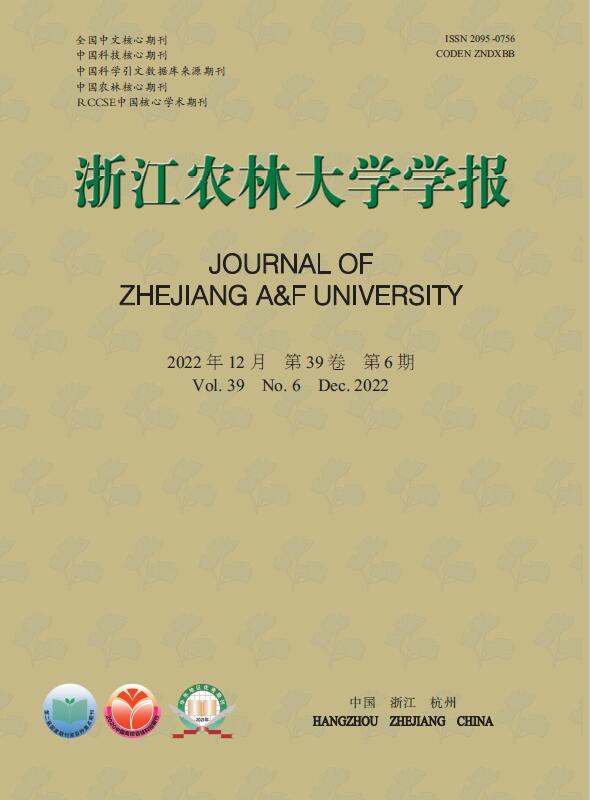-
植物多样性是衡量植物群落结构稳定性和功能复杂性的重要指标之一[1-2],增加林下植物多样性能够提高人工林的稳定性,促进生态系统功能的发挥[3]。林下植物在改善土壤理化性质、促进人工林养分循环、维护物种多样性等方面发挥着重要作用[4]。有关林下植物多样性的研究多集中在林龄、林分密度、平均胸径等非空间结构因子[5-7]和海拔、土壤等环境因子方面[8-9]。林分空间结构是森林经营过程中最容易调控的因子[10],可通过直接改变林下植物生长的微环境,对林下植物多样性产生较大影响[11]。常见的林分空间结构参数包括角尺度、大小比数、混交度等[12]。已有研究表明:林分空间结构对林下植物多样性具有显著影响[13-14]。黎芳等[11]对飞播马尾松Pinus massoniana林的研究中已经发现了林分空间结构各参数对林下植物多样性的影响有差异,然而影响林下植物多样性的主导因子并不明确。在森林经营过程中,如何采取科学合理的措施对林分空间结构进行调整,进而增加林下植物多样性,这对于培育健康稳定的森林生态系统具有重要价值。目前,有关林分空间结构与林下植物多样性的研究多以栎类[14]、松类[15]等为对象,且多集中于天然林、次生林等林分类型,而针对人工林的相关研究较少。黄山松Pinus taiwanensis是中国特有造林树种,具有重要的生态和经济价值。本研究以河南大别山区黄柏山林场黄山松人工林为研究对象,采用灰色关联度分析、Pearson相关分析和典型相关分析方法,探讨了影响黄山松人工林林下草本、灌木和更新树种植物多样性最关键的林分空间结构因子,以期为林分空间结构调整和健康稳定森林营造工作提供科学依据。
-
研究区位于河南省信阳市商城县黄柏山林场九峰尖林区(31°23′~31°35′N,115°13′~115°20′E),属北亚热带向南暖温带过渡地带。研究区主要乔木种为黄山松、杉木Cunninghamia lanceolata等;主要灌木种为山胡椒Lindera glauca、盐肤木Rhus chinensis、油茶Camellia oleifera等;主要草本植物为中华鳞毛蕨Dryopteris chinensis、荩草Arthraxon hispidus、悬铃叶苎麻Boehmeria tricuspis等;主要更新树种为黄山松、麻栎Quercus acutissima等。
-
2020年11月,在研究区选取生长条件基本一致,林分年龄为40~50 a的黄山松人工林地块,利用典型取样法共设置30个20 m×30 m的方形样地,并按照相邻网格法分割为6个10 m×10 m的乔木层调查小样方,对每个小样方内乔木(胸径≥5 cm)的树种名称、坐标、胸径、树高等基本测树因子进行记录。其中,乔木坐标由POSTEX林地定位仪测量。此外,在每个样地的西北角、东南角和中心共设置3个1 m×1 m小样方用于调查草本植物,在西北角和东南角共设置2个2 m×2 m小样方用于调查灌木,并将小样方内的乔木树种(0.2 m<幼苗高度<1.0 m;幼树高度≥1.0 m且胸径<5 cm)记为更新树种,按照先灌木幼树后草本幼苗的顺序对小样方内灌草、更新树种进行调查,记录物种名称、数量和盖度等因子以及海拔、坡向和坡度等样地基本调查因子。根据样地所在小班经营历史,除5 a进行1次以清理枯死木、伐除劣质木为主要措施的抚育间伐之外,没有其他采伐活动。基本情况见表1。
样地号 海拔/m 坡度/(°) 坡向 郁闭度 株密度/(株·hm−2) 平均胸径/cm 平均树高/m 1 845.4 13 西 0.72 767 21.9 10.9 2 834.5 17 西北 0.70 567 22.7 11.5 3 841.4 0 0.65 400 26.4 12.1 4 902.9 23 西南 0.80 1 234 15.9 9.8 5 886.9 35 东南 0.74 1 217 17.2 9.4 6 853.8 17 西 0.75 1 000 18.0 9.8 7 901.2 25 东北 0.71 1 017 18.2 10.4 8 939.8 18 东北 0.70 834 18.6 9.9 9 944.3 18 北 0.72 717 18.6 10.0 10 881.3 22 东北 0.75 967 21.1 10.6 11 912.7 30 北 0.76 1 084 16.2 10.8 12 909.2 18 东南 0.80 1 034 19.6 11.5 13 839.0 26 西北 0.75 1 034 20.1 11.2 14 839.0 32 南 0.72 1 100 17.7 10.1 15 817.4 20 东北 0.76 917 18.9 10.3 16 820.1 26 西南 0.85 1 584 17.9 10.4 17 829.4 10 西北 0.86 1 450 16.8 9.7 18 778.3 20 西 0.82 884 18.1 10.1 19 862.2 23 西北 0.80 1 400 16.5 10.1 20 824.0 31 西北 0.90 1 167 18.9 10.6 21 790.1 17 西 0.76 734 19.9 10.5 22 831.4 25 西北 0.67 433 21.6 12.3 23 840.9 28 西 0.52 333 24.6 12.8 24 756.2 35 西北 0.52 500 26.6 12.1 25 776.4 17 西 0.78 500 25.3 13.0 26 813.5 34 南 0.75 517 20.2 10.7 27 823.2 20 东北 0.83 617 20.4 10.9 28 792.7 27 西北 0.82 1 067 20.7 12.2 29 794.2 31 西北 0.85 917 21.9 13.2 30 782.4 23 西 0.86 1 417 20.0 10.9 Table 1. Basic information of the sampling plots
-
以4株木法确定林分空间结构单元,选用角尺度、混交度、空间密度指数、林层指数、开敞度和Hegyi竞争指数等6个林分空间结构参数来反映整个林分空间结构特征。角尺度表示林木的水平空间分布格局[16],取值范围为[0.475, 0.517]时,林分空间分布格局为随机分布,当角尺度<0.475时为均匀分布,当角尺度>0.517时为团状分布;混交度用于分析树种间相互隔离程度[17],混交度取值划分为0.00,(0.00, 0.25],(0.25, 0.50],(0.50, 0.75]和(0.75,1.00]共5个区间,分别表示林分内林木间的零度混交、弱度混交、中度混交、强度混交以及极强度混交;空间密度指数用来描述林木空间分布密度状况[18],取值在[0.00, 0.50],(0.50, 0.75],(0.75, 1.00]区间内,分别表示林木之间为均匀分布、随机分布和聚集分布;林层指数代表林分垂直方向上林层结构的复杂程度[19],取值区间为(0, 1],其值越大,说明林分在垂直方向上的成层性就越复杂;开敞度用于描述林分的开阔程度[20],取值划分为(0.00, 0.20],(0.20, 0.30],(0.30, 0.4],(0.40, 0.50]和(0.50, + ∞),分别表示林分状态为严重不足、不足、基本充足、充足以及很充足。Hegyi竞争指数反映了林木受近邻木的竞争强烈程度[21],取值在[0, 6),[6, 12),[12, 18),[18, ∞)区间,分别表示弱度、低度、中度、强度4个竞争等级。
根据上述林分空间结构参数变异系数值大小,将变异系数≤10%,>10%~<100%,≥100%划分为弱度、中等和强度变异性[22]。
-
选用物种Simpson优势度指数(Ds)、Shannon多样性指数(H)、Pielou均匀度指数(J)以及Margalef丰富度指数(Ma)[23]来描述林下草本、灌木和更新树种植物多样性水平。
-
采用标准化的方法消除指标数值的量纲。将影响林下植物多样性的林分空间结构参数(角尺度、混交度、空间密度指数、林层指数、开敞度和竞争指数)作为子序列(Xi),i=1, 2, 3, 4
$,\cdots , $ n;分别将林下草本、灌木和更新树种植物多样性指标(Ds、H、J、Ma)作为母序列(X0),且X0=[X0(1), X0(2)$,\cdots , $ X0(k)],Xi=[Xi(1), Xi(2)$,\cdots , $ Xi(k)]。以此分析林分空间结构参数与林下植物多样性指标的关联程度。子序列与母序列在某一时刻的紧密程度可用关联系数表示[24]。通常将因子重要性同等看待,来计算等权关联度(ri)。 -
采用Winkelmass、Excel 2019计算样地林分空间结构参数,R-4.1.0中的Vegan包计算植物多样性指数。采用DPS计算林分空间结构与林下植物多样性的灰色关联度;采用SPSS 25.0计算Pearson相关系数;采用R-4.1.0计算检验林分空间结构参数分别与林下草本、灌木、更新树种植物多样性指标之间最优线性组合的典型载荷以及典型相关系数。
-
从表2可知:该黄山松人工林林分空间结构参数均属于中等变异,其中竞争指数(CI)和开敞度(K)的变异程度较大,变异系数分别为39.7%和31.3%。还可看出,研究区林分角尺度(W)均值为0.48,属于理想的随机分布状态;林分混交度(M)均值是0.67,说明该林分处于强度混交;林分空间密度指数(D)均值为0.47,表明林木空间分布密度为均匀分布;林层指数(S)为0.14~0.60,且均值小于0.50,说明林分在垂直方向上的成层性相对简单;开敞度均值为0.32,表明林分生长空间基本充足;Hegyi竞争指数为0.46~4.89,说明林分处于弱度竞争状态。
林分空间
结构参数均值±标准误 中位数 最大值 最小值 标准差 变异系
数/%W 0.48±0.01 0.48 0.56 0.36 0.05 10.4 M 0.67±0.02 0.75 0.84 0.55 0.08 11.9 D 0.47±0.04 0.48 0.66 0.25 0.11 23.4 S 0.41±0.01 0.40 0.60 0.14 0.08 19.1 K 0.32±0.02 0.28 0.66 0.20 0.10 31.3 CI 2.85±0.21 3.11 4.89 0.46 1.13 39.7 Table 2. Spatial structure parameter of P. taiwanensis plantation stand
-
由表3可以看出:研究区草本、灌木和更新树种的Margalef丰富度指数(Ma)分别为0.51~1.52、0.35~1.86、0.48~2.28,这3个指数在林下植物中变化较大,变异系数分别为31.8%、44.9%和33.6%。
林下植物 多样性指数 均值±标准误 中位数 最大值 最小值 标准差 变异系数/% 草本 Ds 0.63±0.03 0.64 0.83 0.21 0.17 27.0 H 1.23±0.07 1.24 1.89 0.44 0.39 31.7 J 0.80±0.02 0.83 0.99 0.40 0.16 19.4 Ma 0.85±0.05 0.79 1.52 0.51 0.27 31.8 灌木 Ds 0.50±0.02 0.50 0.78 0.20 0.12 24.0 H 0.79±0.05 0.69 1.56 0.35 0.26 32.9 J 0.88±0.02 0.92 1.00 0.50 0.18 20.5 Ma 0.89±0.07 0.87 1.86 0.35 0.40 44.9 更新树种 Ds 0.67±0.02 0.69 0.82 0.44 0.10 14.9 H 1.26±0.06 1.28 1.82 0.64 0.31 24.6 J 0.92±0.01 0.92 1.00 0.77 0.05 5.4 Ma 1.46±0.09 1.54 2.28 0.48 0.49 33.6 Table 3. Understory plant diversity in P. taiwanensis plantation
-
由表4可知:林分角尺度(W)与草本植物多样性指数H、Ma灰色关联程度最大,林分混交度与草本植物多样性指数Ds、J关联度最大,说明林分水平空间结构因子(W、M)是影响研究区林下草本植物多样性的主要因子,且W的关联度系数大于M。从Pearson相关性结果可知:W、竞争指数(CI)与草本植物多样性指数H、Ma呈极显著正相关(P<0.01),空间密度指数(D)与草本植物多样性指数H、Ma存在显著正相关(P<0.05),其中W显著性最大;M与草本植物多样性指数J呈显著正相关(P<0.05),林层指数(S)与草本植物多样性指数H、J、Ma相关系数均最小,且不显著(P>0.05)。
林分空间结构参数 林下草本植物多样性指标 Ds H J Ma 灰色关联度分析 W 0.708 5(4) 0.840 6(1) 0.660 3(6) 0.848 6(1) M 0.733 6(1) 0.657 4(4) 0.751 1(1) 0.660 3(4) D 0.709 9(3) 0.701 5(2) 0.695 5(4) 0.687 7(2) S 0.699 7(5) 0.629 6(5) 0.728 6(2) 0.616 6(5) K 0.688 1(6) 0.595 4(6) 0.683 9(5) 0.582 9(6) CI 0.732 0(2) 0.677 4(3) 0.716 5(3) 0.666 3(3) Pearson相关分析 W 0.104 0.937** −0.098 0.943** M 0.252 0.357 0.393* 0.355 D 0.122 0.403* 0.122 0.382* S 0.200 0.199 0.017 0.193 K −0.032 0.215 0.326 0.195 CI 0.146 0.546** 0.072 0.524** 说明:**、*分别表示显著相关水平P<0.01、P<0.05;括号中数字是排序号 Table 4. Grey correlation degree (order) and Pearson correlation coefficient between stand spatial structure and understory herb plant diversity
典型相关性结果选用α在0.05的水平上检验后得到的最佳变量。根据研究区林分空间结构参数与林下草本植物多样性指标的计算可知,其最优变量U1和V1的典型相关系数为0.998 5,得出典型变量的线性组合为:
其中:U1是林下草本植物多样性指标对应的林分空间结构参数的线性组合。由上述线性组合可知:混交度(M)和角尺度(W)的载荷均较大,开敞度(K)和林层指数(S)的载荷均较小,分别为0.059 5、0.172 7和0.000 9、0.001 4,说明乔木层林木的林分水平空间结构(M、W)在对林下草本植物多样性的影响力上占主导地位,林分垂直空间结构(K、S)对林下灌木植物多样性的影响最小。V1是林下草本植物多样性指标的线性组合,其中变量Ma的载荷较大,说明对林分空间结构参数较为敏感的是草本的丰富度指数。
-
由表5可知:林分混交度(M)与灌木植物多样性指数J、Ma灰色关联度最大,林分角尺度(W)与灌木植物多样性指数Ds关联度最大,林分空间密度指数(D)与灌木植物多样性指数H关联度最大,说明林分水平空间结构因子(M、W、D)是影响研究区林下灌木植物多样性的主要因子。Pearson相关分析结果显示:角尺度、竞争指数与灌木植物多样性指数Ds存在极显著正相关(P<0.01),空间密度指数与Ds呈显著正相关(P<0.05),W与Ds相关性最大;M与灌木植物多样性指数H、J、Ma相关系数最大,且M与H、Ma呈显著正相关(P<0.05)。K与J、Ma相关系数最小,且均不显著(P>0.05)。
林分空间结构参数 林下灌木植物多样性指标 Ds H J Ma 灰色关联度分析 W 0.861 1(1) 0.721 9(5) 0.871 5(4) 0.848 6(5) M 0.663 3(4) 0.733 0(3) 0.659 2(1) 0.660 3(1) D 0.695 6(2) 0.753 0(1) 0.694 6(3) 0.687 7(3) S 0.627 2(5) 0.732 2(4) 0.621 4(5) 0.616 6(4) K 0.597 6(6) 0.709 6(6) 0.595 0(6) 0.582 9(6) CI 0.675 2(3) 0.751 9(2) 0.672 0(2) 0.666 3(2) Pearson相关分析 W 0.952** 0.136 0.104 0.093 M 0.337 0.375* 0.252 0.442* D 0.397* 0.302 0.122 0.189 S 0.182 0.226 0.200 0.233 K 0.202 0.136 −0.032 0.090 CI 0.525** 0.308 0.146 0.190 说明:**、*分别表示显著相关水平P<0.01、P<0.05;括号中数字是排序号 Table 5. Grey correlation degree (order) and Pearson correlation coefficient between stand spatial structure and understory shrub plant diversity
根据研究区林分空间结构参数与林下灌木植物多样性指标的计算可知其最优变量间U2和V2的典型相关系数为0.999 5,得出典型变量的线性组合为:
其中:U2是林下灌木植物多样性指标对应的林分空间结构参数的线性组合。由上述线性组合可知:其角尺度(W)、混交度(M)的载荷均较大,林层指数(S)、开敞度(K)的载荷均较小,其值分别为0.175 8、0.056 4和0.000 5、0.001 7,说明乔木层林木的林分水平空间结构(W、M)在对林下灌木植物多样性的影响力上占主导地位,林分垂直空间结构(S、K)对其影响最小。V2是林下灌木植物多样性指标的线性组合,其中Ds的载荷较大,说明林下灌木优势度指数对林分空间结构参数较为敏感。
-
由表6可知:林分混交度(M)与更新树种植物多样性指数Ds和H关联度最大,林分空间密度指数(D)与更新树种植物多样性指数J、Ma关联度最大,且M的关联度大于D,说明林分水平空间结构因子(M、D)是影响研究区林下更新树种植物多样性的主要因子。D与更新树种植物多样性指数Ma的Pearson相关性最大,呈极显著相关(P<0.01),混交度与更新树种植物多样性指数Ds、H相关系数最大,K与Ds、H相关系数最小,且均不显著(P>0.05)。
林分空间结构参数 林下更新树种植物多样性指标 Ds H J Ma 灰色关联度分析 W 0.708 5(4) 0.717 5(4) 0.687 5(5) 0.630 8(6) M 0.733 6(1) 0.744 7(1) 0.694 1(3) 0.657 2(5) D 0.709 9(3) 0.722 6(3) 0.730 1(1) 0.689 0(1) S 0.699 7(5) 0.710 5(5) 0.715 3(2) 0.668 5(3) K 0.688 1(6) 0.700 0(6) 0.692 2(4) 0.667 3(4) CI 0.732 0(2) 0.739 6(2) 0.674 8(6) 0.674 4(2) Pearson相关分析 W 0.104 0.104 −0.021 −0.021 M 0.252 0.245 0.012 0.117 D 0.122 0.099 −0.085 0.491** S 0.200 0.191 0.251 0.006 K −0.032 −0.051 −0.221 0.208 CI 0.146 0.134 −0.261 0.266 说明:**、*分别表示显著相关水平P<0.01、P<0.05;括号中数字是排序号 Table 6. Grey correlation degree (order) and Pearson correlation coefficient between stand spatial structure and understory regeneration plant diversity
根据研究区林分空间结构参数与林下更新树种植物多样性指标的计算可得其最大典型相关系数为0.681 6,但未通过典型相关系数检验,得出典型变量的线性组合为:
其中:U3是林下更新树种植物多样性指标对应的林分空间结构参数的线性组合,V3是林下更新树种植物多样性指标的线性组合。
-
本研究发现:林分水平空间结构因子角尺度、混交度与草本植物多样性的灰色关联度最大,其中角尺度关联度大于混交度。与曹小玉等[25]结论相似,即角尺度和混交度是影响天然次生林林下草本物种多样性的主要空间结构因子;但刘红民等[24]研究结论不尽相同,认为混交度是影响林下草本多样性的最大关键因子,这可能是由于本研究区域立地质量、林分类型等不同所导致。Pearson相关分析结果显示:角尺度与林下草本植物多样性指数H、Ma相关性最大,呈极显著正相关(P<0.01),混交度与林下草本植物多样性指数J存在显著相关(P<0.05),表明随着角尺度和混交度的增大能够提高林下草本多样性。典型相关结果表明:林分水平空间结构(混交度、角尺度)在对林下草本植物多样性的影响力上占主导地位。这说明角尺度是影响林下草本植物多样性的主导因子,角尺度表征林分水平分布格局,增大角尺度可能影响了乔木冠层和林冠间隙的分布,进而影响到土壤的温度和水分,促进了研究区内土壤的养分循环过程[26],从而提高了草本植物多样性。
-
林分水平空间结构因子混交度、角尺度和空间密度指数与灌木植物多样性的灰色关联度最大,其中混交度的关联程度大于角尺度和空间密度指数。Pearson相关分析结果显示:角尺度与灌木植物多样性指数Ds相关系数为0.952,呈极显著正相关(P<0.01),混交度与灌木植物多样性指数H、J、Ma相关性最大,混交度与H、Ma呈显著正相关(P<0.05)。这说明混交度是影响林下灌木植物多样性的主导因子,树种隔离程度越大,林下灌木植物多样性程度也越大,这与朱光玉等[14]研究结果一致。典型相关结果也表明:林分水平空间结构因子(角尺度、混交度)对林下灌木植物多样性的影响最大。混交度表征林分水平空间结构,混交度会对林内生境条件造成影响[27],增大混交度影响了乔木层各树种间的相互作用,这种相互作用为林下灌木生长释放了营养空间,提高了营养资源的利用水平[28],从而增加了林下灌木植物多样性。
-
林分水平空间结构因子混交度、空间密度指数是影响林下更新树种植物多样性的主要因子,但混交度的灰色关联度大于林分空间密度指数,说明混交度是影响林下更新树种植物多样性主导因子。Pearson相关结果也表明,更新树种植物多样性指数Ma与空间密度指数的相关系数为0.491,存在极显著相关(P<0.01),更新树种植物多样性指数Ds、H与混交度相关系数最大。上述发现与董莉莉等[29]研究发现混交度对更新树种植物多样性有显著影响一致,说明在改善树种隔离的同时,要优化林木空间分布密度,这能够提升林下更新树种的更新潜力,有利于增加林下更新树种植物多样性[30]。
此外,本研究发现:林分垂直空间结构因子开敞度、林层指数对林下草本、灌木、更新树种植物多样性灰色关联程度较小,且与林下植物多样性指数均无显著相关。典型相关分析结果也显示:林分垂直空间结构因子林层指数、开敞度对林下草本和灌木植物多样性的影响程度最小。这与张亚昊等[31]发现开敞度对物种多样性无显著相关的结果存在相似性,可能是本研究区林层结构较为简单,林下植物对枯枝落叶分布以及光斑分布并不敏感。
林下植被发育与林分特征密切相关,其中林分郁闭度、林分密度、林冠结构等是影响林下植被的重要因子。已有大量研究表明:林分密度、郁闭度、林冠结构与林下物种多样性存在密切关系。如王媚臻等[32]研究发现:随林分密度降低,灌木层多样性指数呈先增后减的单峰变化,草本层多样性指数呈先增后减再增再减的双峰变化;赵燕波等[33]研究发现:随郁闭度减小,林下植物多样性指数都呈增大趋势,但更小郁闭度可能会导致林下多样性相对减小,不利于林地地力维持。综合而言,林分密度和郁闭度过大或过小,均不利于林下植物的生长。林冠结构也会影响林下草本层的结构和多样性,不同林冠梯度下的林下植被物种组成因林下光照强弱而不同[34]。但本研究仅讨论了6个林分空间结构参数对林下植物多样性的影响,不够全面。今后可以尝试引入林分密度、郁闭度等林分特征因子进一步探讨。
-
林分空间结构与林下草本、灌木、更新树种植物多样性之间存在密切联系。林分水平空间结构对林下植物多样性影响最大,竞争因子次之,林分垂直空间结构最小。其中,角尺度是影响林下草本植物多样性的关键因子,混交度是影响林下灌木和更新树种植物多样性的关键因子。在今后的造林经营中,可通过调控林分水平空间分布格局,改善林木的竞争态势和垂直空间分布格局等方式以达到提高林下植物多样性的目的,促使黄山松人工林朝着健康稳定的森林生态系统方向发展。
Effects of stand spatial structure on understory plant diversity in Pinus taiwanensis plantation
doi: 10.11833/j.issn.2095-0756.20220139
- Received Date: 2022-01-21
- Accepted Date: 2022-07-11
- Rev Recd Date: 2022-06-24
- Available Online: 2022-11-21
- Publish Date: 2022-12-20
-
Key words:
- stand spatial structure /
- understory plant diversity /
- grey correlation analysis /
- Pearson relational analysis /
- canonical correlation analysis
Abstract:
| Citation: | LÜ Kangting, ZHANG Ershan, LI Siying, et al. Effects of stand spatial structure on understory plant diversity in Pinus taiwanensis plantation[J]. Journal of Zhejiang A&F University, 2022, 39(6): 1257-1266. DOI: 10.11833/j.issn.2095-0756.20220139 |












 DownLoad:
DownLoad: